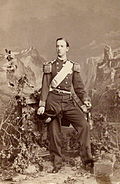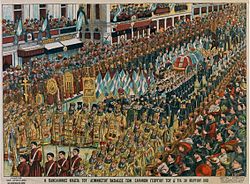George I of Greece
George I (Greek: Γεώργιος Αʹ, Geórgios I; born Prince William of Schleswig-Holstein-Sonderburg-Glücksburg; Danish: [Prins Vilhelm] Error: {{Lang}}: text has italic markup (help); 24 December 1845 – 18 March 1913) also known as Georgios I was King of Greece from 1863 until his assassination in 1913.
| George I | |
|---|---|
 George I in the uniform of an Admiral of the Royal Hellenic Navy | |
| King of the Hellenes | |
| 30 March 1863 – 18 March 1913[1] | |
| Predecessor | Otto I |
| Successor | Constantine I |
| Prime Ministers | See list
|
| Born | Prince William of Schleswig-Holstein-Sonderburg-Glücksburg 24 December 1845 Copenhagen, Denmark |
| Died | 18 March 1913 (aged 67) Thessaloniki[2] |
| Burial | Royal Cemetery, Tatoi Palace, Greece |
| Spouse | |
| Issue | Constantine I of Greece Prince George Princess Alexandra Prince Nicholas Princess Maria Princess Olga Prince Andrew Prince Christopher |
| House | Glücksburg |
| Father | Christian IX of Denmark |
| Mother | Louise of Hesse Kassel |
| Religion | Lutheranism |
| Signature |  |
George's reign of almost 50 years (the longest in modern Greek history) was characterized by territorial gains as Greece established its place in pre-World War I Europe. He was the grandfather of Prince Philip, Duke of Edinburgh and great-grandfather of Charles III.
While out on an afternoon walk near the White Tower on 18 March 1913, he was shot at close range in the back by Alexandros Schinas, who was "said to belong to a Socialist organization" and "declared when arrested that he had killed the King because he refused to give him money".[3] George died instantly, the bullet having penetrated his heart.[4]
George I Of Greece Media
Portrait by August Schiøtt, 1853
Expansion of the Greek kingdom from 1832 to 1947. Thessaly transferred from Ottoman to Greek sovereignty in 1881.
Greek satirical cartoon of the 1880s. The legend reads "Greece at the peak of its progress and its greatness". The Greek royal princes play music to which the country dances, while Prime Minister Trikoupis applauds and King George I is shown in an olive tree, the symbol of Trikoupis's party.
Assassination of George I as depicted in a contemporary lithograph
Funeral of King George I in Athens
References
- ↑ Throughout George's lifetime, Greece used the Old Style Julian calendar. Unless otherwise indicated, all dates in this article are in the New Style Gregorian calendar.
- ↑ At the time of the King's assassination, Thessaloniki was in occupied Ottoman territory. The city was recognized as part of the Kingdom of Greece by the Treaty of Bucharest (1913) five months afterwards.
- ↑ The Times (London), 19 March 1913, p. 6
- ↑ Christmas, p. 408
Other websites
- Vilhelm (Georg I) at the website of the Royal Danish Collection at Amalienborg Palace








